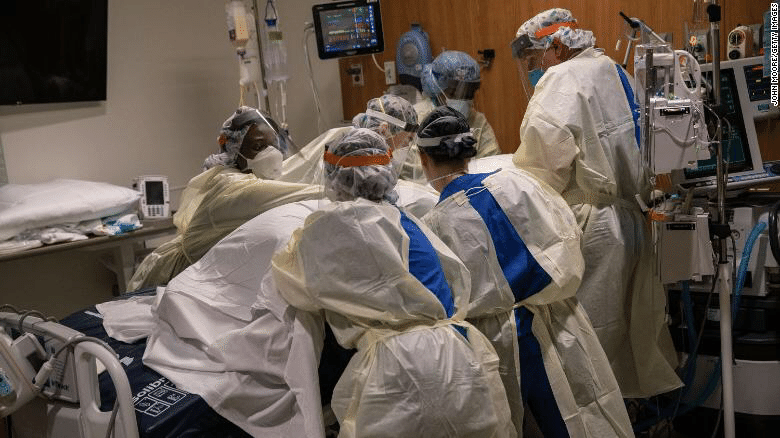
Expert report predicts up to two more years of pandemic misery≒ 専門家の報告によると、パンデミックの悲惨さは最大2年間と予測

Expert report predicts up to two more years of pandemic misery
By Maggie Fox, CNN
Updated 3:41 AM EDT, Fri May 01, 2020
(CNN)The new coronavirus is likely to keep spreading for at least another 18 months to two years—until 60% to 70% of the population has been infected, a team of longstanding pandemic experts predicted in a report released Thursday.
They recommended that the US prepare for a worst-case scenario that includes a second big wave of coronavirus infections in the fall and winter. Even in a best-case scenario, people will continue to die from the virus, they predicted.
"This thing's not going to stop until it infects 60 to 70 percent of people," Mike Osterholm, who directs the Center for Infectious Disease Research and Policy (CIDRAP) at the University of Minnesota, told CNN.
"The idea that this is going to be done soon defies microbiology."
Osterholm has been writing about the risk of pandemics for 20 years and has advised several presidents. He wrote the report along with Harvard School of Public Health epidemiologist Marc Lipsitch, who is also a top expert on pandemics; Dr. Kristine Moore, a former Centers for Disease Control and Prevention epidemiologist who is now medical director for CIDRAP; and historian John Barry, who wrote the 2004 book "The Great Influenza" about the 1918 flu pandemic.
Waiting for herd immunity
Because Covid-19 is new, no one has any immunity, they said. "The length of the pandemicwill likely be 18 to 24 months, as herd immunity gradually develops in the human population," they wrote.
Their predictions are different from models presented by groups such as the Institute for Health Metrics and Evaluation (IHME) at the University of Washington or the models produced by Imperial College London, whose report predicting millions of deaths in the US and UK helped galvanize responses by both governments.
The CIDRAP-led team used those reports, historical data on past pandemics, and published reports about the medical details of Covid-19 to put together their forecast.
Deaths spiked as Covid-19 spread in March and April, new analysis finds
Deaths spiked as Covid-19 spread in March and April, new analysis finds
"I have said for a long time that when you are trying to understand how infectious disease is going to unfold, you should rely on history as well as models," Lipsitch told CNN. For instance, pandemic infections don't tend to die down in the summer, like seasonal flu does., he said.
Covid-19 is most comparable to a pandemic strain of influenza, they said.
"Because of a longer incubation period, more asymptomatic spread, and a higher R0, COVID-19 appears to spread more easily than flu," they wrote in the report. R0 is the average number of other people infected by each patient.
"A higher R0 means more people will need to get infected and become immune before the pandemic can end," they add. "Based on the most recent flu pandemics, this outbreak will likely last 18 to 24 months."
Preparing for the worst
They said government officials should stop telling people the pandemic could be ending and instead prepare citizens for a long haul.
Three scenarios are possible, they said:
Scenario 1: The first wave of Covid-19 in spring 2020 is followed by a series of repetitive smaller waves that occur through the summer and then consistently over a one- to two-year period, gradually diminishing sometime in 2021
Scenario 2: The first wave of Covid-19 is followed by a larger wave in the fall or winter and one or more smaller waves in 2021. "This pattern will require the reinstitution of mitigation measures in the fall in an attempt to drive down spread of infection and prevent healthcare systems from being overwhelmed," they wrote. "This pattern is similar to what was seen with the 1918-19 pandemic."
Model predicts Covid-19 pandemic will 'peter out' by May, but experts are skeptical
Model predicts Covid-19 pandemic will 'peter out' by May, but experts are skeptical
Scenario 3: A "slow burn" of ongoing transmission. "This third scenario likely would not require the reinstitution of mitigation measures, although cases and deaths will continue to occur."
States and territories should plan for scenario 2, the worst-case scenario, they recommended.
"Government officials should develop concrete plans, including triggers for reinstituting mitigation measures, for dealing with disease peaks when they occur," they advised.
Lipsitch and Osterholm both said they are surprised by the decisions many states are making to lift restrictions aimed at controlling the spread of the virus.
"I think it's an experiment. It's an experiment that likely will cost lives, especially in places that do it without careful controls to try to figure out when to try to slow things down again," Lipsitch said.
Plus, he said, some states are choosing to lift restrictions when they have more new infections than they had when they decided to impose the restrictions.
"It is hard to even understand the rationale," Lipsitch said.
A vaccine could help, the report said, but not quickly. "The course of the pandemic also could be influenced by a vaccine; however, a vaccine will likely not be available until at least sometime in 2021," they wrote.
"And we don't know what kinds of challenges could arise during vaccine development that could delay the timeline."
専門家の報告によると、パンデミックの悲惨さは最大2年間予測
マギー・フォックス、CNN
2020年5月1日金曜日午前3時41分東部夏時間更新
(CNN)新しいコロナウイルスは、人口の60%から70%が感染するまで、少なくともさらに18か月から2年間感染し続ける可能性が高いと、長年のパンデミック専門家チームが木曜日に発表されたレポートで予測しました。
彼らは米国に、秋と冬にコロナウイルス感染の第2の大きな波を含む最悪のシナリオに備えることを推奨しました。 最良のシナリオでさえ、人々はウイルスによって死ぬだろうと彼らは予測した。
ミネソタ大学感染症研究政策センター(CIDRAP)を率いるマイク・オスターホルム氏はCNNに、「これは60〜70%の人が感染するまで止まらない」と語った。
「これがまもなく行われるだろうという考えは、微生物学に反するものです。」
オスターホルムは20年間パンデミックのリスクについて書いており、いくつかの大統領に助言してきました。 彼は、ハーバード公衆衛生学部の疫学者であるMarc Lipsitchとともにレポートを書きました。MarcLipsitchは、パンデミックの専門家でもあります。 元疾病管理予防センターの疫学者であるクリスティン・ムーア博士は、現在CIDRAPの医学部長を務めています。 そして歴史家のジョン・バリーは、1918年のインフルエンザの大流行について2004年の本「大インフルエンザ」を書いた。
群れの免疫を待っています
Covid-19は新しいので、誰も免疫を持たない、と彼らは言った。 「群れの免疫が人間の人口で次第に発達するので、パンデミックの長さはおそらく18から24か月になるでしょう」と彼らは書きました。
彼らの予測は、ワシントン大学の健康指標評価研究所(IHME)などのグループによって提示されたモデルや、米国および英国での数百万人の死亡を予測するレポートが 両方の政府。
CIDRAP主導のチームは、それらのレポート、過去のパンデミックに関する履歴データ、およびCovid-19の医学的詳細に関する公開レポートを使用して、彼らの予測をまとめました。
Covid-19が3月と4月に蔓延したことで死亡数が急増、新しい分析で発見
Covid-19が3月と4月に蔓延したことで死亡数が急増、新しい分析で発見
「感染症がどのように進展するかを理解しようとしているときは、モデルだけでなく歴史にも頼るべきだと長い間言ってきた」とリプシッチはCNNに語った。 例えば、パンデミック感染症は、季節性インフルエンザのように夏に死亡する傾向はありません、と彼は言った。
Covid-19はインフルエンザのパンデミック株に最も匹敵すると彼らは言った。
「COVID-19は潜伏期間が長く、無症状で広がり、R0が高いため、インフルエンザよりも広がりやすいようです」と彼らは報告書に書いている。 R0は、各患者に感染した他の人の平均数です。
「より高いR0は、パンデミックが終わる前に、より多くの人々が感染して免疫になる必要があることを意味します」と彼らは付け加えます。 「最新のインフルエンザの大流行に基づいて、この発生はおそらく18から24ヶ月続くでしょう。」
最悪の事態に備える
彼らは、政府当局者がパンデミックが終息する可能性があることを人々に伝えるのをやめ、代わりに市民に長期的な準備をさせるべきだと述べました。
3つのシナリオが可能であると彼らは言った:
シナリオ1:2020年春のCovid-19の最初の波の後に、夏の間、一連の繰り返しの小さな波が続き、その後1年から2年の期間にわたって一貫して、2021年に徐々に減少します
シナリオ2:Covid-19の最初の波の後に、秋または冬に大きな波が続き、2021年に1つ以上の小さな波が続きます。「このパターンでは、拡散を促進するために、秋に緩和策を再設定する必要があります。 感染の防止と医療システムの圧倒を防ぐ」と述べた。 「このパターンは、1918-19年のパンデミックで見られたものに似ています。」
モデルはCovid-19のパンデミックが5月までに「盛り上がる」と予測していますが、専門家は懐疑的です
モデルはCovid-19のパンデミックが5月までに「盛り上がる」と予測していますが、専門家は懐疑的です
シナリオ3:進行中の感染の「ゆっくりとしたやけど」。 「この3番目のシナリオでは、ケースと死が引き続き発生するが、緩和策の再設定はおそらく必要ないでしょう。」
州および準州は、最悪のシナリオであるシナリオ2を計画する必要があると推奨しました。
「政府当局者は、緩和策を再開するためのトリガーを含め、発症時にピークに対処するための具体的な計画を策定する必要がある」と彼らは助言した。
LipsitchとOsterholmはどちらも、ウイルスの蔓延を抑制することを目的とした制限を解除するために多くの州が下している決定に驚いていると述べました。
「私はそれは実験だと思う。それは、物事を再び遅くしようとするときを理解することを試みるために注意深い制御なしにそれを行う場所で、特に人命を犠牲にするであろう実験だ」とリプシッチは言った。
さらに、いくつかの州では、規制を課すことを決定したときよりも新しい感染が多い場合に、規制を解除することを選択しています。
「理論的根拠さえ理解するのは難しい」とリプシッチは言った。
ワクチンは役立つかもしれないと報告書は述べたが、迅速ではない。 「パンデミックの経過もワクチンの影響を受ける可能性があります。しかし、ワクチンは少なくとも2021年のいつか利用できるようになるでしょう」と彼らは書いた。
「そして、我々は、ワクチン開発中にタイムラインを遅らせる
